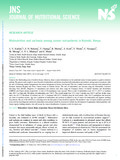| dc.description.abstract | Cancer is the third leading cause of death in Kenya. However, there is scarce information on the nutritional status of cancer patients to guide in decision making. The present study sought to assess the risk of malnutrition, and factors associated with malnutrition and cachexia, among cancer out-patients, with the aim of informing nutrition programmes for cancer management in Kenya and beyond. This was a facility-based cross-sectional study performed at Kenyatta National Hospital and Texas Cancer Centre in Nairobi, Kenya. The risk of malnutrition was assessed using the Malnutrition Universal Screening Tool (MUST). Diagnoses of malnutrition and cachexia were done using the European Society of Clinical Nutrition and Metabolism (ESPEN) and Fearon criteria, respectively. A total of 512 participants were assessed. Those at risk of malnutrition were 33·1 % (12·5 % at medium risk, 20·6 % at high risk). Prevalence of malnutrition was 13·4 %. The overall weight loss >5 % over 3 months was 18·2 % and low fat-free mass index was 43·1 %. Prevalence of cachexia was 14·1 % compared with 8·5 % obtained using the local criteria. Only 18·6 % participants had received any form of nutrition services. Age was a predictor of malnutrition and cachexia in addition to site of cancer for malnutrition and cigarette smoking for cachexia. The use of the MUST as a screening tool at the first point of care should be explored. The predictive value of current nutrition assessment tools, and the local diagnostic criteria for malnutrition and cachexia should be reassessed to inform the development of appropriate clinical guidelines and
future capacity-building initiatives that will ensure the correct identification of patients at risk for timely care. | en_US |

